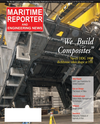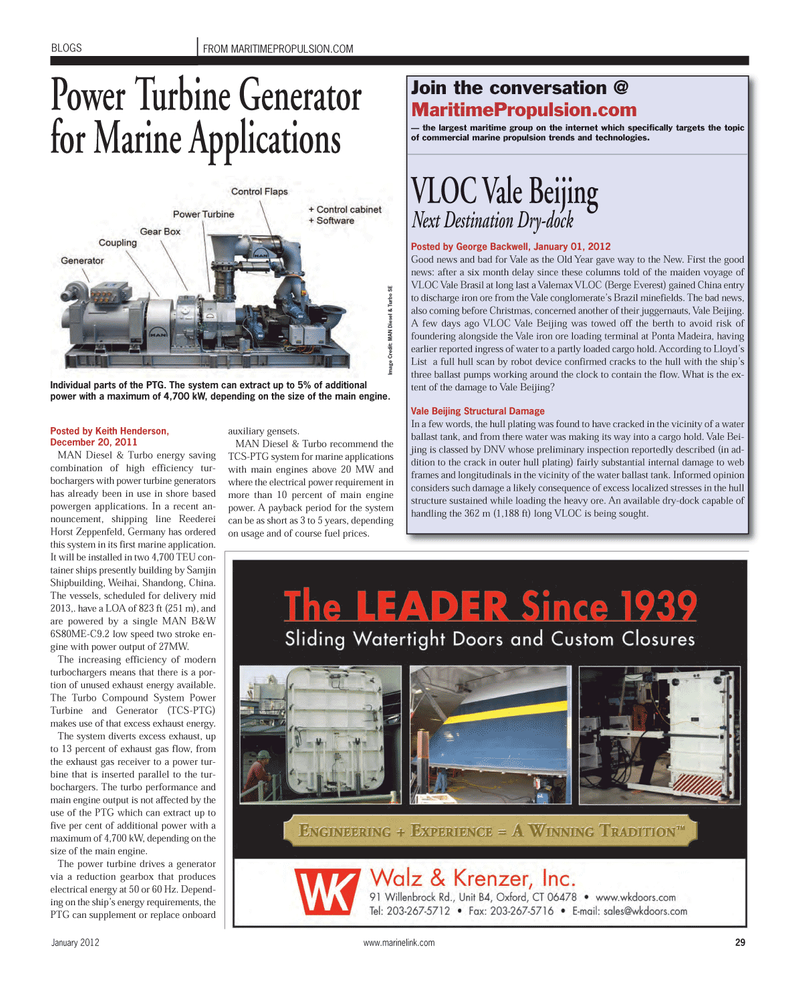
Page 29: of Maritime Reporter Magazine (January 2012)
US Navy Report
Read this page in Pdf, Flash or Html5 edition of January 2012 Maritime Reporter Magazine
Posted by Keith Henderson, December 20, 2011 MAN Diesel & Turbo energy saving combination of high efficiency tur- bochargers with power turbine generators has already been in use in shore basedpowergen applications. In a recent an- nouncement, shipping line ReedereiHorst Zeppenfeld, Germany has ordered this system in its first marine application. It will be installed in two 4,700 TEU con- tainer ships presently building by Samjin Shipbuilding, Weihai, Shandong, China. The vessels, scheduled for delivery mid 2013,. have a LOA of 823 ft (251 m), and are powered by a single MAN B&W 6S80ME-C9.2 low speed two stroke en- gine with power output of 27MW. The increasing efficiency of modern turbochargers means that there is a por- tion of unused exhaust energy available. The Turbo Compound System Power Turbine and Generator (TCS-PTG) makes use of that excess exhaust energy. The system diverts excess exhaust, up to 13 percent of exhaust gas flow, from the exhaust gas receiver to a power tur- bine that is inserted parallel to the tur- bochargers. The turbo performance and main engine output is not affected by the use of the PTG which can extract up to five per cent of additional power with a maximum of 4,700 kW, depending on the size of the main engine.The power turbine drives a generator via a reduction gearbox that produceselectrical energy at 50 or 60 Hz. Depend- ing on the ship?s energy requirements, the PTG can supplement or replace onboardauxiliary gensets.MAN Diesel & Turbo recommend the TCS-PTG system for marine applicationswith main engines above 20 MW and where the electrical power requirement in more than 10 percent of main enginepower. A payback period for the system can be as short as 3 to 5 years, dependingon usage and of course fuel prices.January 2012www.marinelink.com 29BLOGSFROM MARITIMEPROPULSION.COMJoin the conversation @ MaritimePropulsion.com ? the largest maritime group on the internet which specifically targets the topic of commercial marine propulsion trends and technologies. VLOC Vale Beijing Next Destination Dry-dock Posted by George Backwell, January 01, 2012 Good news and bad for Vale as the Old Year gave way to the New. First the good news: after a six month delay since these columns told of the maiden voyage of VLOC Vale Brasil at long last a Valemax VLOC (Berge Everest) gained China entry to discharge iron ore from the Vale conglomerate?s Brazil minefields. The bad news, also coming before Christmas, concerned another of their juggernauts, Vale Beijing. A few days ago VLOC Vale Beijing was towed off the berth to avoid risk of foundering alongside the Vale iron ore loading terminal at Ponta Madeira, having earlier reported ingress of water to a partly loaded cargo hold. According to Lloyd?s List a full hull scan by robot device confirmed cracks to the hull with the ship?s three ballast pumps working around the clock to contain the flow. What is the ex- tent of the damage to Vale Beijing? Vale Beijing Structural Damage In a few words, the hull plating was found to have cracked in the vicinity of a water ballast tank, and from there water was making its way into a cargo hold. Vale Bei- jing is classed by DNV whose preliminary inspection reportedly described (in ad-dition to the crack in outer hull plating) fairly substantial internal damage to web frames and longitudinals in the vicinity of the water ballast tank. Informed opinion considers such damage a likely consequence of excess localized stresses in the hull structure sustained while loading the heavy ore. An available dry-dock capable of handling the 362 m (1,188 ft) long VLOC is being sought. Power Turbine Generator for Marine Applications Image Credit: MAN Diesel & Turbo SE Individual parts of the PTG. The system can extract up to 5% of additional power with a maximum of 4,700 kW, depending on the size of the main engine. MR Jan.12 # 4 (26-33):MR Template 1/10/2012 12:00 PM Page 29

 28
28

 30
30
